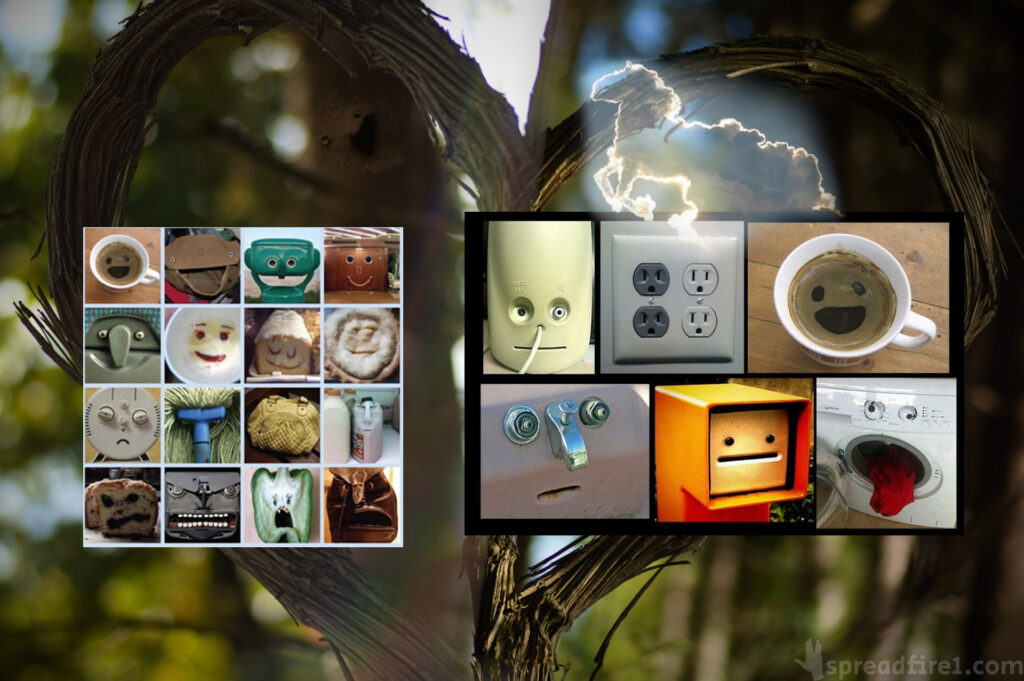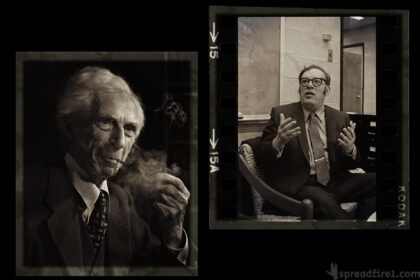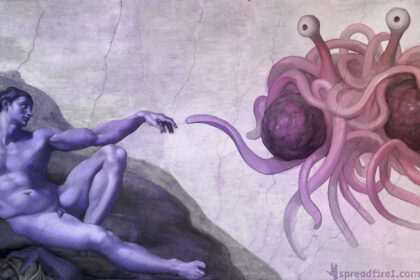|
Blogcast - listen to the audio version
|
…and how all this affects our daily lives.


Physics, amirite? So interesting to see the coincidence of a beechnut falling into exactly that spot and staying there for me to photograph. “Doesn’t it get old?”, I ask myself. Always having to ascribe meaning or purpose or to interpret patterns. The human condition is fascinating. Self-proclaimed sophisticated and evolutionarily ‘advanced’, yet slaves to our instincts and senses, much like our dear animal cousins. Maybe in a few million years, our bodies or technology will have evolved/advanced enough to make that possible. We’ll see what the future brings. Well, not we specifically, but our descendants might. Given they manage to survive for that long without destroying the only inhabitable planet within reach, so far.
Humans are pattern-seeking story-telling animals, and we are quite adept at telling stories about patterns, whether they exist or not.
Michael Shermer
Pareidolia
Pareidolia is the tendency for incorrect perception of a stimulus as an object, pattern or meaning known to the observer, such as seeing shapes in clouds, seeing faces in inanimate objects or abstract patterns, or hearing hidden messages in music.
Common examples are perceived images of animals, faces, or objects in cloud formations, the Man in the Moon, the Moon rabbit, and other lunar pareidolia. The concept of pareidolia may extend to include hidden messages in recorded music played in reverse or at higher- or lower-than-normal speeds, and hearing indistinct voices in random noise such as that produced by air conditioners or fans.
Pareidolia was at one time considered a symptom of human psychosis, but it is now seen as a normal human tendency. It is not confined to humans. Scientists have for years taught computers to use visual clues to “see” faces and other images.
The word derives from the Greek words para (παρά, “beside, alongside, instead [of]”) and the noun eidōlon (εἴδωλον “image, form, shape”)
Signs & Meaning
No need to overinterpret any deeper meaning. Resist the urge to read into things what’s not there, even if you wish it were. Reflect, don’t project.
spreadfirequotes by yours truly
“Always try to remember that most of the things that happen in this world aren’t signs. They happen because they happen, and their only real significance lies in normal cause and effect. You’ll drive yourself crazy if you start trying to pry the meaning out of every gust of wind or rain squall. I’m not denying that there might actually be a few signs that you won’t want to miss. Knowing the difference is the tricky part.”
David Eddings
Daily Life Examples
So why is it important to question our instincts? To take the time and effort to think rationally? Read more in my article ‘A New Age of Reason And Enlightenment‘.
Leophobia – an irrational fear of lions?
Back in the day, and I mean thousands and hundreds of thousands of years ago, when we, Homo sapiens, lived in caves as hunter-gatherers to survive. So back in those days, we had to rely on our instincts. Better to run away a hundred times from a rustling in the grass that could be a lion hunting for human prey. Even if 99 times it was just the wind. Better safe than sorry/dead. We were better off trusting the instinct to run away. That meant survival to pass on our genes. So this overly careful and anxious behavior was evolutionarily beneficial. While the inquisitive and questioning specimen died out. Simply put. Of course, these are not absolutes, not black & white, but gradual expressions of genetic traits.
Today, we don’t have to rely solely on instincts to survive anymore. We are relatively safe. No lion is trying to eat us. We have food and shelter, for the most part. So we can afford the luxury of questioning our instincts. To think and investigate in order to confirm our first instinctive feelings. We have to be aware of our biological traits. Then we can actively try to counteract any irrational behaviors that stem from them.
We ascribe agency in various situations. A three-year-old child, trying to make sense of the world, uses this concept too. Playing catch, an inanimate object like a chair suddenly actively “catches the ball” landing on it and becomes part of the storytelling narrative. “Why did the wind blow so hard? I didn’t want it to knock my bike over.” Reading purpose or intent into physical phenomena. It seems this is an innate human trait, evolved for survival.
Children don’t have the mental capacities yet to understand the real underlying reasons. Add their dependency on parents and we have the perfect setup for indoctrination. But eventually, we grow up to think for ourselves and stop believing in the tooth fairy, Santa Claus, and gods. Okay, without wishful thinking, the latter only applies to a small number of people. The vast majority will cling on tight to their indoctrinated superstitions. Even though they are in the same category, some beliefs are harder to outgrow.
Covid-19 Pattern-Seeking and Story-Telling
Astrology, homeopathy and other esoteric nonsense fall into that category as well. So, as Michael Shermer eloquently put, “Humans are pattern-seeking story-telling animals, and we are quite adept at telling stories about patterns, whether they exist or not.”. We see patterns everywhere. In nature, in shapes and forms, in numbers, in sounds.
Although this is a deeper and more complex topic, this aspect is apparent in the current misinformation landscape of the COVID-19 pandemic, too. Statistics and graphs are misinterpreted or deliberately presented in a misleading way to strengthen one’s own narrative. We cherry-pick data, only seeing what we want to see.
Counting the Hits, Ignoring the Misses
Every Friday the weather starts getting bad, so my weekends are always rainy. (Except for the ones that aren’t rainy.) That’s just my bad luck…or God is punishing me…or ‘karma’. Notwithstanding the fact that there is no higher intrinsic purpose tailored to my person or to any other of the 8 billion individuals on this planet. This common but false pattern recognition can be explained briefly:
1. Selective perception and memory that favors and amplifies negative events.
2. Based on this false data, we think there is a repeating pattern.
3. We invent a narrative and tell a story based on 1 & 2.
Like with many other biases and flaws of the human brain, it is important to be mindful of them. Only then we can actively work around or overcome them.










